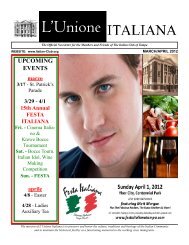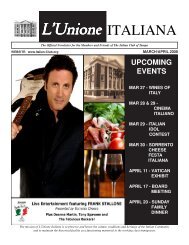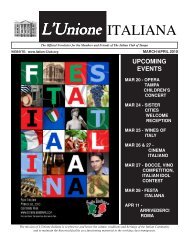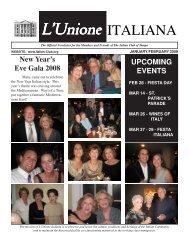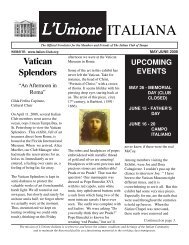Create successful ePaper yourself
Turn your PDF publications into a flip-book with our unique Google optimized e-Paper software.
JANUARY/FEBRUARY 2005<strong>Italian</strong> Perspectives:By“<strong>The</strong> Riace Statues”John IorioThrough the warm water <strong>of</strong> the IonianSea on an August day in 1972, he saw it –an arm emerging from the sandy bottom25 feet down <strong>of</strong>f Riace on the Calabriancoast. Stefano Mariottini, the amateurdiver-archaeologist, knew it was animportant find. Verification and researchconfirmed Mariottini’s view that he hadglided into one <strong>of</strong> the most significantartistic discoveries <strong>of</strong> the century.Layered by the accrual <strong>of</strong> nearly 2000years <strong>of</strong> sea life, two statues <strong>of</strong> Greekwarriors emerged from the sea bottom.This discovery added significantly to thehandful <strong>of</strong> bronze statues left to us fromthe Classical period.Now it was time for museums, tourism,economies, regional pride, andtechnology to take over. Preliminarywork was done at Reggio. <strong>The</strong>n thestatues were sent to Florence where thetechnology was available to restore theworks to their primitive brilliance. <strong>The</strong>delays, showings, and distrust <strong>of</strong>Florentine motives ignited a conflictbetween Reggio and FlorenceHad this been the Renaissance therewould have been war, and we would bereading a history as follows:Reggio persuaded Sicily to join in therecovery <strong>of</strong> the statues. Caesar Borgia,who had a Florentine negotiator killedwhen he recognized him as his halfbrother, led the Southern armies.Florence formed an alliance with Genoaand Milan and chose Caterina Sforza tocommand the Northern armies. Romegave its blessing to both sides. Da Vinciwas commissioned to paint the battle, andthere was hope that perhaps he wouldfinish something for a change.But the idea <strong>of</strong> unraveling was thesubtext <strong>of</strong> all Renaissance adventures. InPalermo, the bastard son <strong>of</strong> the duketreacherously killed his uncle andwithdrew support for Reggio. Spainattacked Palermo for no reason. CaterinaSforza, seduced by Borgia, decided thestatues were not worth it and relinquishedher command to Andria Doria, who knewnothing about land warfare. <strong>The</strong> evilduke <strong>of</strong> Mantua witnessed the seductionand reported it to the Pope, whereuponthe Pope urged Lucrezia to do what shedid best with her brother. Caesar died thefollowing weekend. <strong>The</strong> alliance wasbadly strained.<strong>The</strong> confrontation took place inCampania. <strong>The</strong> Neapolitans hosted thebattle and <strong>of</strong>fered to supply the food, butthe <strong>of</strong>fer was rejected after tenNeapolitan testers died <strong>of</strong> foodpoisoning. After a major battle, a dozenor so knights were killed. <strong>The</strong> statues,meanwhile, had been forgotten anddisappeared.All seriousness aside, the statues werereturned to Reggio, thanks to democraticconventions and agreements.We took the students in three buses tostudy the works. We waited until themuseum opened and waited longer untilthe museum was able to accommodate us.I saw Reggio as an attractive city. I hadread that it was a center <strong>of</strong> production <strong>of</strong>essence oils used in the manufacture <strong>of</strong>perfumes and this fact might have giventhe shops along the Corso Garibaldi asophisticated edge. <strong>The</strong> city was bustlingand hustling, leading me to wonder whator where was the prime mover in all thisactivity. We and all other busloads <strong>of</strong>visitors coming and going would nothave been here had it not been for thestatues, and it gives support to those whosee the arts as economic stimulus,evidence that where the arts flourish, theeconomy thrives.We were treated to two remarkable lifesizestatues. And both statues, as Scholarsbelieve, are from the 5 th century B.C. Onestatue is <strong>of</strong> a young warrior, strong, withcurly beard and a gaze worthy <strong>of</strong> a ClintEastwood. <strong>The</strong> youthful head is turnedslightly to the right. Parted lips revealsilver teeth. His straight right leg speaksPAGE 16<strong>of</strong> stability and strength while his bentleft leg reminds one <strong>of</strong> the contrapostalgrace <strong>of</strong> Michelangelo’s “David.” Hisweapon and shield are missing, butthanks to art his body remains tense,ready for combat and self assured. <strong>The</strong>other statue is an older man, dubbed “<strong>The</strong>Old Man.” What else? Also minus hisheadgear, weapon and shield, he exudesmore <strong>of</strong> an inner serenity, his life perhapsmolded by years <strong>of</strong> combat. For me thestatues seem to bridge the self containedspiritualty <strong>of</strong> 5 th century B.C. works andthe commanding presence <strong>of</strong> much laterand Roman works.Some scholars see the two as works fromdifferent hands. <strong>The</strong> youth may be a workby Phidias from about 460 BC, while theold man is ascribed to Polyclitus <strong>of</strong> about430 B.C.. Look up the Doryphorus <strong>of</strong>Polyclitus (440 B.C) and you will findthe resemblance astounding (except forthe face). Some have suggested that theyare commemorative statues dedicated tothe victory at Marathon.Yet others claim with equalpersuasiveness that they are the work <strong>of</strong>Pythagorus who worked in Reggio in the5 th centurt B.C. Pythagorus was the firstto depict the kind <strong>of</strong> detail( the showing<strong>of</strong> veins, for example) found in thestatues. Yet I find veins in theDoryphorus as well.Mysteries remain. Many questions beganswers. Both mysteries and questionsmay always be unsolved and unanswered.



